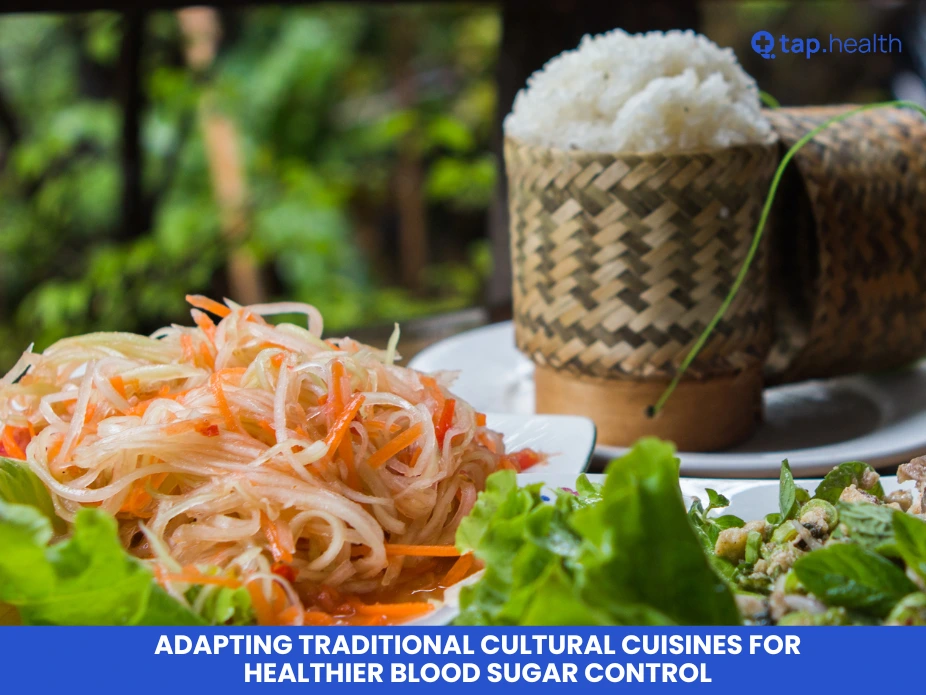Food is a cornerstone of culture, bringing people together and preserving traditions across generations. However, many traditional cuisines can pose challenges for individuals managing blood sugar levels, particularly those with diabetes. Adapting these beloved dishes to promote healthier blood sugar control doesn’t mean sacrificing flavor or heritage. Instead, it involves making thoughtful substitutions and modifications that retain the essence of the cuisine while enhancing its nutritional profile. This comprehensive guide explores how to adapt traditional cultural cuisines for better blood sugar management, supported by real-life scenarios, expert insights, and evidence-based recommendations.
Understanding Blood Sugar Control and Traditional Cuisines
Blood sugar control is essential for maintaining overall health and preventing complications related to diabetes. Traditional cuisines often include ingredients and cooking methods that can impact blood sugar levels, such as high-carbohydrate foods, sugary desserts, and fried dishes. However, with mindful adjustments, these traditional foods can be made healthier without losing their cultural significance.
Key Components Affecting Blood Sugar Levels
- Carbohydrates: The primary macronutrient influencing blood sugar. High-carb foods can cause rapid spikes in blood glucose.
- Glycemic Index: Measures how quickly a food raises blood sugar levels. Low-GI foods lead to gradual increases, aiding better blood sugar control.
- Fiber: Slows down the absorption of sugar, promoting stable blood glucose levels.
- Healthy Fats and Proteins: Enhance satiety and slow carbohydrate digestion, preventing blood sugar spikes.
- Portion Sizes: Managing the quantity of food consumed is crucial for maintaining balanced blood sugar levels.
Adapting Traditional Cuisines for Healthier Blood Sugar Control
Adapting traditional dishes involves making strategic changes to ingredients and cooking methods to improve their nutritional value. Here are some general strategies:
1. Substitute Refined Carbohydrates with Whole Grains
Example: Replace white rice with brown rice, quinoa, or barley in dishes like stir-fries and pilafs. Whole grains have a lower glycemic index and higher fiber content, aiding in better blood sugar management.
2. Incorporate More Vegetables
Example: Add extra vegetables to soups, stews, and casseroles. Vegetables are low in carbohydrates and high in fiber, vitamins, and minerals, enhancing the nutritional profile of traditional meals.
3. Use Healthy Fats
Example: Swap butter or lard with olive oil, avocado oil, or coconut oil for sautéing and frying. Healthy fats help slow down the digestion of carbohydrates, preventing rapid blood sugar spikes.
4. Choose Lean Proteins
Example: Opt for lean cuts of meat, skinless poultry, fish, legumes, and tofu instead of fatty meats. Proteins are essential for muscle maintenance and satiety, helping to control hunger and blood sugar levels.
5. Reduce Added Sugars
Example: Modify desserts by using natural sweeteners like stevia, erythritol, or monk fruit instead of refined sugar. Additionally, increase the use of fruits to add natural sweetness and fiber.
6. Control Portion Sizes
Example: Serve smaller portions of high-carb dishes and increase servings of vegetables and proteins. Using smaller plates can help manage portion sizes effectively.
Real-Life Scenarios
Understanding how to adapt traditional dishes through real-life examples can provide practical insights into managing blood sugar levels without compromising cultural heritage.
Scenario 1: Traditional Indian Curry
Original Dish: Chicken Tikka Masala served with white basmati rice and naan bread.
Healthier Adaptation:
- Rice Substitute: Replace white basmati rice with brown basmati rice or quinoa.
- Bread Substitute: Use whole-grain naan or make naan with whole wheat flour.
- Cooking Method: Use olive oil instead of ghee or butter and reduce the amount of cream in the sauce by substituting with Greek yogurt.
- Vegetable Addition: Add vegetables like bell peppers, spinach, or cauliflower to the curry for extra fiber and nutrients.
Impact: These changes lower the glycemic load of the meal, increase fiber intake, and provide healthier fats, contributing to more stable blood sugar levels.
Scenario 2: Italian Pasta Dish
Original Dish: Spaghetti Carbonara made with refined pasta, bacon, and creamy sauce.
Healthier Adaptation:
- Pasta Substitute: Use whole-grain spaghetti or spiralized vegetables like zucchini noodles (zoodles).
- Protein Substitute: Replace bacon with lean turkey bacon or add chickpeas for plant-based protein.
- Sauce Modification: Make the sauce with a blend of Greek yogurt and a small amount of Parmesan cheese instead of heavy cream.
- Vegetable Addition: Incorporate peas, mushrooms, or spinach to boost fiber and nutrient content.
Impact: These modifications reduce refined carbohydrates and unhealthy fats while increasing fiber and protein, aiding in better blood sugar control.
Scenario 3: Mexican Tacos
Original Dish: Beef tacos with white corn tortillas, sour cream, and cheese.
Healthier Adaptation:
- Tortilla Substitute: Use whole-grain or low-carb tortillas, or opt for lettuce wraps.
- Protein Substitute: Choose lean ground turkey or black beans instead of beef.
- Topping Modification: Use Greek yogurt instead of sour cream and add plenty of fresh vegetables like lettuce, tomatoes, and onions.
- Cheese Portion: Use a smaller amount of cheese or choose a low-fat variety.
Impact: These changes decrease refined carbohydrates and unhealthy fats while increasing fiber and protein, contributing to more stable blood glucose levels.
Scenario 4: Middle Eastern Hummus
Original Dish: Traditional hummus made with tahini, olive oil, and pita bread.
Healthier Adaptation:
- Pita Substitute: Serve hummus with raw vegetables like carrot sticks, cucumber slices, or bell pepper strips instead of pita bread.
- Ingredient Modification: Use less olive oil and add more lemon juice and garlic for flavor without extra fat.
- Additional Protein: Add chickpeas or a side of grilled chicken to increase protein content.
Impact: These modifications lower the glycemic load by reducing high-carb bread, increase fiber and protein, and maintain the rich flavors of the dish.
Expert Contributions
Insights from nutritionists, dietitians, and culinary experts highlight the importance and feasibility of adapting traditional cuisines for better blood sugar control.
Dr. Anjali Mehta, Registered Dietitian
“Traditional cuisines are deeply rooted in culture and identity. Adapting these dishes for better blood sugar control doesn’t mean losing the essence of the cuisine. It’s about making informed choices and modifications that enhance the nutritional value without compromising on taste.”
Chef Roberto Martinez, Culinary Expert
“Cooking is about creativity and innovation. By experimenting with different ingredients and cooking methods, you can retain the flavors and traditions of your favorite dishes while making them healthier. Small changes can make a big difference in managing blood sugar levels.”
Dr. Emily Chen, Endocrinologist
“Managing blood sugar levels is crucial for preventing complications associated with diabetes. Adapting traditional foods to be more blood sugar-friendly can significantly improve overall health outcomes. It’s essential to work with healthcare professionals to tailor these adaptations to individual needs.”
Recommendations Grounded in Proven Research and Facts
Scientific studies provide evidence-based strategies for adapting traditional cuisines to support healthier blood sugar control. Here are key recommendations supported by research:
1. Emphasize Whole Grains and Fiber
Research Insight: Whole grains and high-fiber foods slow down the digestion and absorption of carbohydrates, leading to more stable blood sugar levels.
Recommendation: Incorporate whole grains like brown rice, quinoa, barley, and whole wheat flour into traditional recipes. Add vegetables and legumes to increase fiber content.
2. Choose Lean Proteins
Research Insight: Lean proteins help increase satiety and reduce the overall glycemic load of meals, aiding in blood sugar management.
Recommendation: Opt for lean meats, poultry, fish, tofu, and legumes in place of higher-fat proteins. Incorporate plant-based proteins to diversify nutrient intake.
3. Incorporate Healthy Fats
Research Insight: Healthy fats, such as those found in olive oil, avocados, nuts, and seeds, can improve insulin sensitivity and help control blood sugar levels.
Recommendation: Use healthy fats in cooking and as dressings. Replace saturated fats with unsaturated fats to enhance the nutritional profile of meals.
4. Reduce Added Sugars and Refined Carbohydrates
Research Insight: High intake of added sugars and refined carbohydrates can lead to rapid spikes in blood sugar levels and increased insulin demand.
Recommendation: Limit the use of sugary ingredients and refined carbs in traditional recipes. Use natural sweeteners like stevia, erythritol, or small amounts of honey, and choose whole-grain or low-carb alternatives.
5. Practice Portion Control
Research Insight: Managing portion sizes helps prevent overeating and excessive carbohydrate intake, which can destabilize blood sugar levels.
Recommendation: Use smaller plates, measure serving sizes, and balance meals with appropriate portions of carbohydrates, proteins, and fats.
6. Incorporate Fermented Foods
Research Insight: Fermented foods like yogurt, kefir, and kimchi contain probiotics that can improve gut health and insulin sensitivity.
Recommendation: Add fermented foods to traditional meals to boost their probiotic content and support blood sugar regulation.
7. Utilize Cooking Methods that Preserve Nutrients
Research Insight: Healthy cooking methods like steaming, grilling, baking, and sautéing with minimal oil help retain the nutritional value of foods without adding excess fat or calories.
Recommendation: Modify traditional cooking techniques to use healthier methods. Avoid deep-frying and excessive use of oils or butters.
8. Balance Macronutrients
Research Insight: A balanced intake of carbohydrates, proteins, and fats is essential for maintaining stable blood sugar levels and overall health.
Recommendation: Ensure that each meal includes a balance of macronutrients. For example, pair carbohydrates with proteins and healthy fats to slow down glucose absorption.
9. Incorporate Antioxidant-Rich Foods
Research Insight: Antioxidants help reduce inflammation and oxidative stress, which are linked to insulin resistance and diabetes complications.
Recommendation: Add colorful vegetables, fruits, nuts, and seeds to traditional dishes to increase their antioxidant content.
10. Stay Hydrated
Research Insight: Proper hydration supports metabolic processes and helps maintain blood sugar levels.
Recommendation: Drink plenty of water throughout the day. Opt for herbal teas or infused water as healthy beverage alternatives.
Factual and Reliable Information
Accurate information is vital for effectively adapting traditional cuisines to support blood sugar control. Here are some key facts to consider:
Carbohydrates and Blood Sugar
- Types of Carbs: Simple carbohydrates (sugars) cause rapid spikes in blood sugar, while complex carbohydrates (whole grains, vegetables) provide a slower, more sustained release of glucose.
- Glycemic Index: Foods with a high glycemic index (e.g., white bread, sugary cereals) raise blood sugar levels quickly, whereas low-GI foods (e.g., legumes, whole grains) do so gradually.
Importance of Fiber
- Benefits: Fiber slows carbohydrate digestion, improves insulin sensitivity, and promotes satiety, aiding in weight management.
- Sources: Whole grains, vegetables, fruits, legumes, nuts, and seeds are excellent sources of dietary fiber.
Healthy Fats and Insulin Sensitivity
- Role of Fats: Healthy fats improve insulin sensitivity and reduce inflammation, which is beneficial for blood sugar control.
- Sources: Olive oil, avocados, nuts, seeds, and fatty fish like salmon are rich in healthy fats.
Protein and Satiety
- Benefits: Protein enhances satiety, reduces appetite, and helps maintain muscle mass, all of which are important for managing blood sugar levels.
- Sources: Lean meats, poultry, fish, tofu, legumes, and dairy products like Greek yogurt are good protein sources.
Impact of Portion Sizes
- Overeating Risks: Consuming large portions of high-carb and high-fat foods can lead to blood sugar spikes and weight gain.
- Control Strategies: Using smaller plates, measuring servings, and balancing meal components can help manage portion sizes effectively.
Cultural Sensitivity in Dietary Adaptations
- Respecting Traditions: Adaptations should honor the cultural significance and flavors of traditional dishes.
- Personalization: Dietary changes should be tailored to individual preferences and nutritional needs, ensuring sustainability and adherence.
Practical Tips for Adapting Traditional Cuisines
Implementing effective strategies can help transform traditional dishes into blood sugar-friendly meals. Here are actionable tips:
1. Smart Ingredient Substitutions
- Whole Grains: Swap white rice, pasta, and bread with their whole-grain counterparts.
- Natural Sweeteners: Use stevia, erythritol, or small amounts of honey instead of refined sugar.
- Lean Proteins: Choose chicken, turkey, fish, or plant-based proteins over fatty meats.
2. Enhance Fiber Content
- Vegetable Additions: Incorporate extra vegetables into soups, stews, casseroles, and stir-fries.
- Legumes: Add beans, lentils, and chickpeas to increase fiber and protein in meals.
3. Healthy Cooking Methods
- Grilling and Baking: Opt for grilling, baking, steaming, or sautéing with minimal oil instead of frying.
- Use of Healthy Oils: Use olive oil or avocado oil instead of butter or lard.
4. Portion Control Techniques
- Smaller Plates: Serve meals on smaller plates to naturally limit portion sizes.
- Balanced Portions: Aim for half the plate to be vegetables, a quarter to be lean protein, and a quarter to be whole grains.
5. Incorporate Fermented Foods
- Yogurt and Kefir: Add yogurt or kefir to meals for probiotics and enhanced gut health.
- Fermented Vegetables: Include kimchi, sauerkraut, or pickles as side dishes.
6. Mindful Eating Practices
- Slow Down: Eat slowly, savor each bite, and pay attention to hunger and fullness cues.
- Eliminate Distractions: Avoid eating while watching TV or working to prevent overeating.
7. Meal Planning and Preparation
- Plan Ahead: Prepare meals in advance to ensure balanced and healthy options are readily available.
- Healthy Recipes: Explore and adapt traditional recipes to include healthier ingredients and cooking methods.
8. Educate and Empower Yourself
- Nutrition Knowledge: Learn about the nutritional impact of different ingredients and how they affect blood sugar.
- Culinary Skills: Develop cooking skills that emphasize healthy preparation techniques and ingredient substitutions.
Sample Meal Plan: Adapting Traditional Cuisines
Creating a balanced meal plan that incorporates adapted traditional dishes can help manage blood sugar levels effectively. Here’s an example of a day’s meals:
Breakfast
Option 1: Whole-Grain Pancakes with Fresh Berries
- Ingredients: Whole-grain pancake mix, eggs, almond milk, fresh blueberries, and a drizzle of pure maple syrup.
- Adaptation: Use whole-grain flour and almond milk to lower the glycemic index. Top with fresh berries for added fiber and antioxidants.
- Blood Sugar Impact: Balanced carbohydrates and fiber help stabilize blood sugar levels.
Option 2: Greek Yogurt with Nuts and Honey
- Ingredients: Plain Greek yogurt, a handful of mixed nuts, and a teaspoon of honey.
- Adaptation: Choose plain yogurt to reduce added sugars and add nuts for healthy fats and protein.
- Blood Sugar Impact: High protein and healthy fats promote satiety and prevent blood sugar spikes.
Mid-Morning Snack
Option 1: Apple Slices with Peanut Butter
- Ingredients: Sliced apple and natural peanut butter.
- Adaptation: Choose unsweetened peanut butter and control portion sizes to manage carbohydrate intake.
- Blood Sugar Impact: Fiber from apples and protein from peanut butter help maintain stable blood sugar levels.
Option 2: Carrot and Celery Sticks with Hummus
- Ingredients: Fresh carrot and celery sticks with a serving of hummus.
- Adaptation: Use homemade or low-sodium hummus to reduce added sugars and sodium.
- Blood Sugar Impact: High fiber and protein content aid in blood sugar control.
Lunch
Option 1: Quinoa Salad with Grilled Chicken and Vegetables
- Ingredients: Cooked quinoa, grilled chicken breast, mixed vegetables (bell peppers, cucumbers, tomatoes), and a lemon-olive oil dressing.
- Adaptation: Use quinoa as a whole grain alternative to white rice and add plenty of vegetables for fiber.
- Blood Sugar Impact: Balanced meal with complex carbohydrates, lean protein, and healthy fats helps stabilize blood sugar.
Option 2: Whole-Grain Wrap with Turkey and Avocado
- Ingredients: Whole-grain tortilla, sliced turkey breast, avocado, lettuce, and mustard.
- Adaptation: Use a whole-grain tortilla and add avocado for healthy fats.
- Blood Sugar Impact: Healthy fats and lean protein slow down carbohydrate digestion, preventing blood sugar spikes.
Afternoon Snack
Option 1: Mixed Nuts and Seeds
- Ingredients: A handful of unsalted mixed nuts and seeds.
- Adaptation: Choose a variety without added sugars or salts.
- Blood Sugar Impact: Healthy fats and protein provide sustained energy and stabilize blood sugar.
Option 2: Cottage Cheese with Pineapple
- Ingredients: Low-fat cottage cheese and fresh pineapple chunks.
- Adaptation: Use low-fat cottage cheese and control the portion of pineapple to manage carbohydrate intake.
- Blood Sugar Impact: Protein from cottage cheese and fiber from pineapple help maintain stable blood sugar levels.
Dinner
Option 1: Baked Salmon with Steamed Vegetables and Brown Rice
- Ingredients: Baked salmon fillet, steamed broccoli and carrots, and a serving of brown rice.
- Adaptation: Use brown rice instead of white rice and bake instead of frying the salmon.
- Blood Sugar Impact: High protein and fiber content support blood sugar control and overall health.
Option 2: Lentil Stew with Whole-Grain Bread
- Ingredients: Lentils, tomatoes, spinach, onions, garlic, and whole-grain bread.
- Adaptation: Increase the proportion of vegetables and use whole-grain bread to enhance fiber intake.
- Blood Sugar Impact: Lentils provide complex carbohydrates and protein, while vegetables add fiber and nutrients.
Evening Snack
Option 1: Dark Chocolate and Almonds
- Ingredients: A small piece of dark chocolate (70% cocoa or higher) and a handful of almonds.
- Adaptation: Choose dark chocolate with minimal added sugars and control portion sizes.
- Blood Sugar Impact: Healthy fats from almonds and antioxidants from dark chocolate support blood sugar stability.
Option 2: Herbal Tea with a Small Fruit Salad
- Ingredients: A cup of herbal tea and a small bowl of mixed fruits (berries, kiwi, and apple).
- Adaptation: Use fresh, low-GI fruits and limit portion sizes to manage carbohydrate intake.
- Blood Sugar Impact: Fiber from fruits and the absence of added sugars help maintain stable blood sugar levels.
Frequently Asked Questions (FAQ) on Adapting Traditional Cultural Cuisines for Healthier Blood Sugar Control
1. Can I still enjoy traditional dishes if I have diabetes?
Absolutely! By making mindful substitutions and adjustments, you can enjoy the flavors and essence of traditional dishes while supporting better blood sugar control.
2. What are some healthy substitutes for white rice in traditional recipes?
Whole grains like brown rice, quinoa, barley, and cauliflower rice are excellent alternatives that provide more fiber and have a lower glycemic index.
3. How can I reduce the carbohydrate content in traditional desserts?
Use natural sweeteners like stevia or erythritol, incorporate more fruits, and replace refined flours with whole-grain or almond flour to reduce carbohydrates in desserts.
4. Are there any traditional cooking methods that are better for blood sugar control?
Yes, methods like grilling, baking, steaming, and sautéing with healthy oils are preferable over frying or using excessive amounts of butter and oil.
5. How important is portion control in managing blood sugar?
Portion control is crucial as it helps prevent overeating and excessive carbohydrate intake, both of which can lead to blood sugar spikes.
6. Can I use herbs and spices to enhance the flavor of healthier traditional dishes?
Absolutely! Herbs and spices not only add flavor without added calories or sugars but also offer various health benefits, including anti-inflammatory properties.
7. How can I make traditional soups and stews healthier?
Add more vegetables, use lean proteins, substitute refined grains with whole grains, and reduce the amount of added salt and fats to make soups and stews healthier.
8. What role do healthy fats play in blood sugar control?
Healthy fats slow down the digestion and absorption of carbohydrates, helping to prevent rapid spikes in blood sugar levels and enhancing satiety.
9. Are plant-based proteins better for managing blood sugar?
Plant-based proteins like legumes, tofu, and tempeh can be excellent choices as they are often lower in saturated fats and higher in fiber, supporting better blood sugar control.
10. How can I stay motivated to adapt traditional recipes for better blood sugar control?
Set realistic goals, involve family members in meal planning and preparation, celebrate small successes, and seek support from healthcare professionals or support groups to stay motivated.
Adapting traditional cultural cuisines for healthier blood sugar control is a practical and enjoyable approach to managing diabetes and promoting overall health. By making informed substitutions, incorporating more fiber and healthy fats, choosing lean proteins, and practicing portion control, you can transform beloved traditional dishes into nutritious meals that support stable blood sugar levels. Embracing these changes not only enhances your dietary habits but also preserves the rich cultural heritage embedded in your favorite foods.
Collaboration with nutritionists, dietitians, and culinary experts can further guide you in making these adaptations effectively. Remember, the goal is to create a balanced and sustainable eating pattern that honors your cultural traditions while fostering better health outcomes. With mindful choices and a willingness to experiment, you can enjoy the best of both worlds—delicious traditional flavors and optimal blood sugar control.
References
- American Diabetes Association. (2023). Standards of Medical Care in Diabetes—2023. Diabetes Care, 46(Supplement 1), S1-S232. https://doi.org/10.2337/dc23-S001
- Journal of Nutrition. (2020). Impact of Whole Grains on Blood Sugar Control. https://www.journalofnutrition.org/article/S0022-3166(20)30134-7/fulltext
- National Institute of Diabetes and Digestive and Kidney Diseases (NIDDK). (2022). Healthy Eating for Diabetes. https://www.niddk.nih.gov/health-information/diabetes/overview/diet-eating-physical-activity
- Centers for Disease Control and Prevention (CDC). (2023). Managing Diabetes with Diet.



